Research on Optimal Scheduling Strategy of Differentiated Resource Microgrid with Carbon Trading Mechanism Considering Uncertainty of Wind Power and Photovoltaic
Abstract
1. Introduction
2. LHS-CTM Microgrid Operation System Structure
2.1. LHS-CTM Microgrid System Operation Process
2.2. Carbon Emissions Market Trading Mechanism
2.3. Latin Hypercube Sampling
3. Optimization Model Considering Demand Response
3.1. Adjustable Load Characteristics
3.2. Characteristics of Distributed Generation
3.3. Energy Storage Characteristics
4. Model Solving Method
4.1. Objective Function
4.2. Constraints
5. Example Analysis
5.1. Parameter Setting
5.2. Analysis of Wind Power Processing Based on LHS
5.3. Low-Carbon Economy Optimal Scheduling Results
6. Discussion
7. Conclusions
- In the case of the randomness of wind power generation and photovoltaic power generation, the accuracy of the output curve prediction is low. In this context, some of the studies use algorithms with higher model complexity to predict it. According to this study, when new energy sources such as photovoltaic power participate in microgrid optimization scheduling, the Latin hypercube sampling method is used to describe the output curve, and the error will not exceed ±5%, which can be compensated by other power generation equipment and energy storage equipment during actual participation.
- In the case of flexible loads participating in the optimal scheduling of the microgrid, this study needs to involve both flexible electrical and thermal loads in the optimal scheduling of the microgrid. In addition, some power generation and energy storage devices have thermal energy at the same time as electrical output, and the two kinds of loads can be used to participate in demand response and obtain subsidies. The comprehensive cost of the microgrid will be greatly reduced.
- For the carbon trading market, adding the carbon trading mechanism to the optimal scheduling of microgrids can not only reduce operating costs but also improve social benefits, facilitate carbon reduction policies, and accelerate the green transformation of the power system. However, due to the risk of carbon trading price volatility and the increase in carbon emissions caused by enterprise development, it is necessary to use new energy and energy storage equipment for reasonable planning and operation to reduce comprehensive costs and carbon emissions.
Author Contributions
Funding
Data Availability Statement
Conflicts of Interest
References
- Han, Y.; Zhang, K.; Li, H.; Coelho, E.A.A.; Guerrero, J.M. MAS-based distributed coordinated control and optimization microgrid and microgrid clusters:a comprehensive overview. IEEE Trans. Power Electron. 2018, 33, 6488–6508. [Google Scholar] [CrossRef]
- Cao, J.; Jin, Y.; Zheng, T. A decentralized robust voltage control method for distribution networks considering the uncertainty of distributed generation clusters. Power Syst. Prot. Control 2023, 51, 155–166. [Google Scholar]
- Shi, C.; An, R.; Gao, H.; Jiang, S.; He, S.; Liu, J. Flexible operation method for a distribution network based on flexible multi-state switching and dynamic reconfiguration. Power Syst. Prot. Control 2023, 51, 133–144. [Google Scholar]
- Yu, Y.; Li, Y.; Chen, S. Distributionally robust optimal dispatch of distribution network considering multiple source-storage coordinated interaction. Electr. Power Eng. Technol. 2021, 40, 192–199. [Google Scholar]
- Sun, Q.; Yu, X.; Wang, J. Discussion on Challenges and Countermeasures of “Double High” Power Distribution System. Proc. CSEE 2024. Available online: http://kns.cnki.net/kcms/detail/11.2107.tm.20240801.0924.004.html (accessed on 2 August 2024).
- Yu, H.; Cai, G.; Shi, S.; Zhang, H.; Peng, D.; Yin, S. Operation Optimization Method for Microgrid with Large-scale Charging Piles. Proc. CSU-EPSA 2022, 34, 16–25. [Google Scholar]
- Xing, Y.; Ren, T. Application research of improved MOPSO in Microgrid optimal dispatch. Acta Energiae Solaris Sin. 2024, 45, 191–200. [Google Scholar]
- Li, J.; Ju, Y.; Zhang, L.; Liu, W.; Wang, J. Multi-time scale distributed robustoptimal schedulingof microgrid based on model predictive control. Electr. Power Eng. Technol. 2024, 43, 45–55. [Google Scholar]
- Khatsu, S.; Srivastava, A.; Das, D.K. Solving Combined Economic Emission Dispatch for Microgrid using Time Varying Phasor Particle Swarm Optimization. In Proceedings of the 2020 6th International Conference on Advanced Computing and Communication Systems (ICACCS), Coimbatore, India, 6–7 March 2020; pp. 411–415. [Google Scholar]
- Sutton, R.S.; Barto, A.G. Reinforcement Learning: An Introduction, 2nd ed.; MIT Press: Cambridge, MA, USA, 2018; pp. 196–205. [Google Scholar]
- Gao, G.; Yang, S.; Guo, X. A Review of Research on the Application of Deep Reinforcement Learning in Optimization Dispatch of Power Grids with Distributed Flexible Resources. Proc. CSEE 2024, 44, 6385–6404. Available online: http://kns.cnki.net/kcms/detail/11.2107.TM.20240612.1139.002.html (accessed on 6 August 2024).
- Tang, G.; Wu, H.; Xu, Z.; Li, Z.T. Two-Stage Robust Optimization for Microgrid Dispatch with Uncertainties. In Proceedings of the 2023 6th International Conference on Energy, Electrical and Power Engineering (CEEPE), Guangzhou, China, 21–23 April 2023; pp. 497–502. [Google Scholar]
- Yang, J.; Ma, P.; Li, L. Two-stage Distributed Robust Energy Storage Capacity Optimization Method for Large-scale Wind Power Access to Microgrid. J. Electr. Eng. 2024. Available online: http://kns.cnki.net/kcms/detail/10.1289.TM.20240322.0945.002.html (accessed on 6 August 2024).
- Pan, J.; Lu, Y.; He, B.; Zhang, X.; Yu, Z.W.; Zhang, X.Z.; Ma, J.H. Research on economic dispatch of microgrid considering uncertainty of wind and solar output. Adv. Technol. Electr. Eng. Energy 2024, 43, 56–64. [Google Scholar]
- Duan, F.; Eslami, M.; Khajehzadeh, M.; Basem, A.; Jasim, D.J.; Palani, S. Optimization of a photovoltaic/wind/battery energy-based microgrid in distribution network using machine learning and fuzzy multi-objective improved Kepler optimizer algorithms. Sci. Rep. 2024, 14, 13354. [Google Scholar] [CrossRef]
- Wang, S.; Yue, Y.; Cai, S.; Li, X.; Chen, C.; Zhao, H.; Li, T. A comprehensive survey of the application of swarm intelligent optimization algorithm in photovoltaic energy storage systems. Sci. Rep. 2024, 14, 17958. [Google Scholar] [CrossRef]
- Yang, X.; Ye, X.; Li, Z.; Wang, X.; Song, X.; Liao, M.; Liu, X.; Guo, Q. Hybrid energy storage configuration method for wind power microgrid based on EMD decomposition and two-stage robust approach. Sci. Rep. 2024, 14, 2733. [Google Scholar] [CrossRef] [PubMed]
- Liang, N.; Miao, M.; Xu, H. Bi-Level Optimal Scheduling of Integrated Energy System Considering Green Certificates-Carbon Emission Trading Mechanism. Acta Energiae Solaris Sin. 2024, 45, 312–322. [Google Scholar]
- Liu, R.; Li, Z.; Yang, X.; Sun, G.; Li, L. Optimal Dispatch of Community Integrated Energy System Considering User-Side-Flexible LOAD. Acta Energiae Solaris Sin. 2019, 40, 2842–2850. [Google Scholar]
- Duan, S.; Jiang, X.; Shang, J. Rolling Clearing Model of Electric Carbon Joint Market Based on Centralized Carbon Trading Mechanism. In Proceedings of the 2023 IEEE 7th Conference on Energy Internet and Energy System Integration (EI2), Hangzhou, China, 15–18 December 2023; pp. 3199–3205. [Google Scholar]
- Deng, W.; Dai, Z.; Lu, C. Research on Output Forecasting of Wind Power and Photovoltaic Complementary Power Plant Based on Adaptive Neural Network. Autom. Instrum. 2024, 97–100+105. [Google Scholar]
- Zhong, M. Multi-Objective Optimal Scheduling of Microgrid Considering Wind and Solar Power Uncertainty and Demand Side Management. Master’s Dissertation, Wuhan University, Wuhan, China, 2022. [Google Scholar]
- Ye, L.; Li, J.; Lu, P. Wind Power Time Series Aggregation Approach Based on Affinity Propagation Clustering and MCMC Algorithm. Proc. CSEE 2020, 40, 3744–3754. [Google Scholar]
- Guo, W.; Wang, G.; Min, Y. Hybrid Energy Storage Capacity Configuration for Traction Power Supply Systems Considering Ladder-type Carbon Trading Mechanism. J. Southwest Jiaotong Univ. 2024. Available online: http://kns.cnki.net/kcms/detail/51.1277.U.20240719.0942.004.html (accessed on 7 August 2024).
- Keshta, H.E.; Hassaballah, E.G.; Ali, A.A.; Abdel-Latif, K.M. Multi-level optimal energy management strategy for a grid tied microgrid considering uncertainty in weather conditions and load. Sci. Rep. 2024, 14, 10059. [Google Scholar] [CrossRef]
- Xu, Y.; Duan, J. Study on joint control of integrated energy microgrid based on stepped carbon trading. Therm. Power Gener. 2024, 53, 105–115. [Google Scholar]
- Wang, R. Optimization Operation Strategy of Carbon Capture Power Plant and Flexible Load Collaborative Consumption of Wind Power. Master’s Thesis, Northeast Electric Power University, Jilin, China, 2024. [Google Scholar]
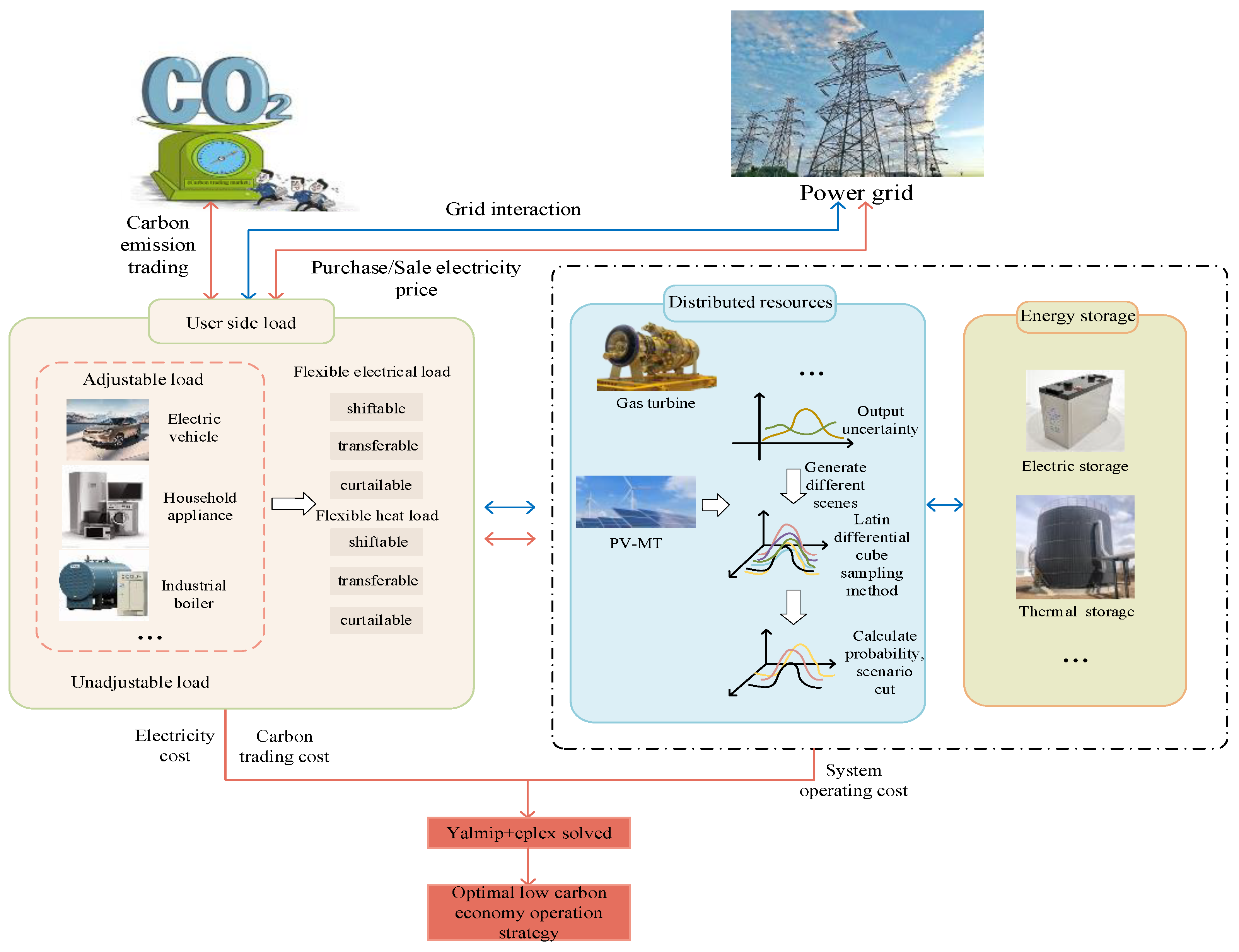
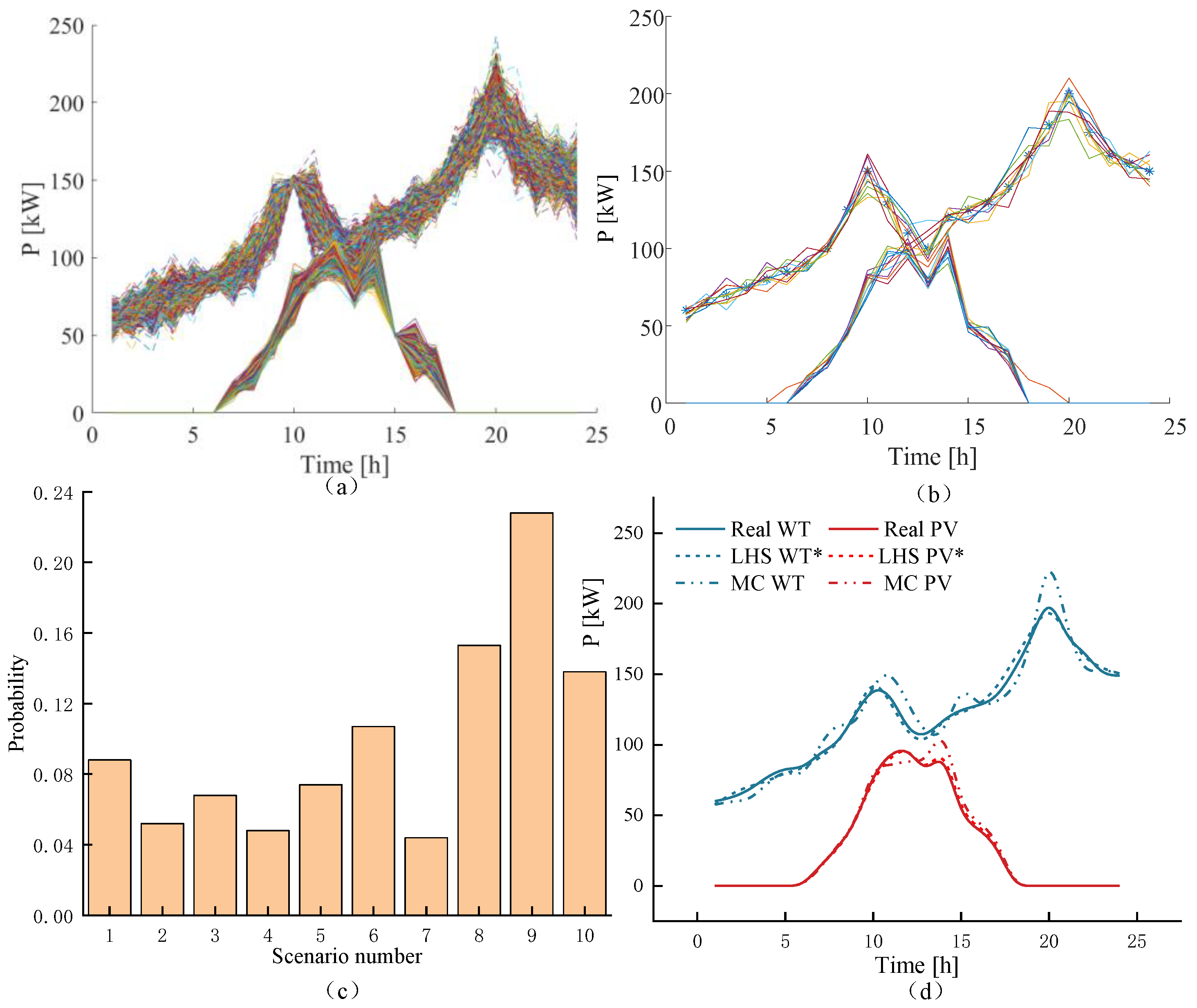
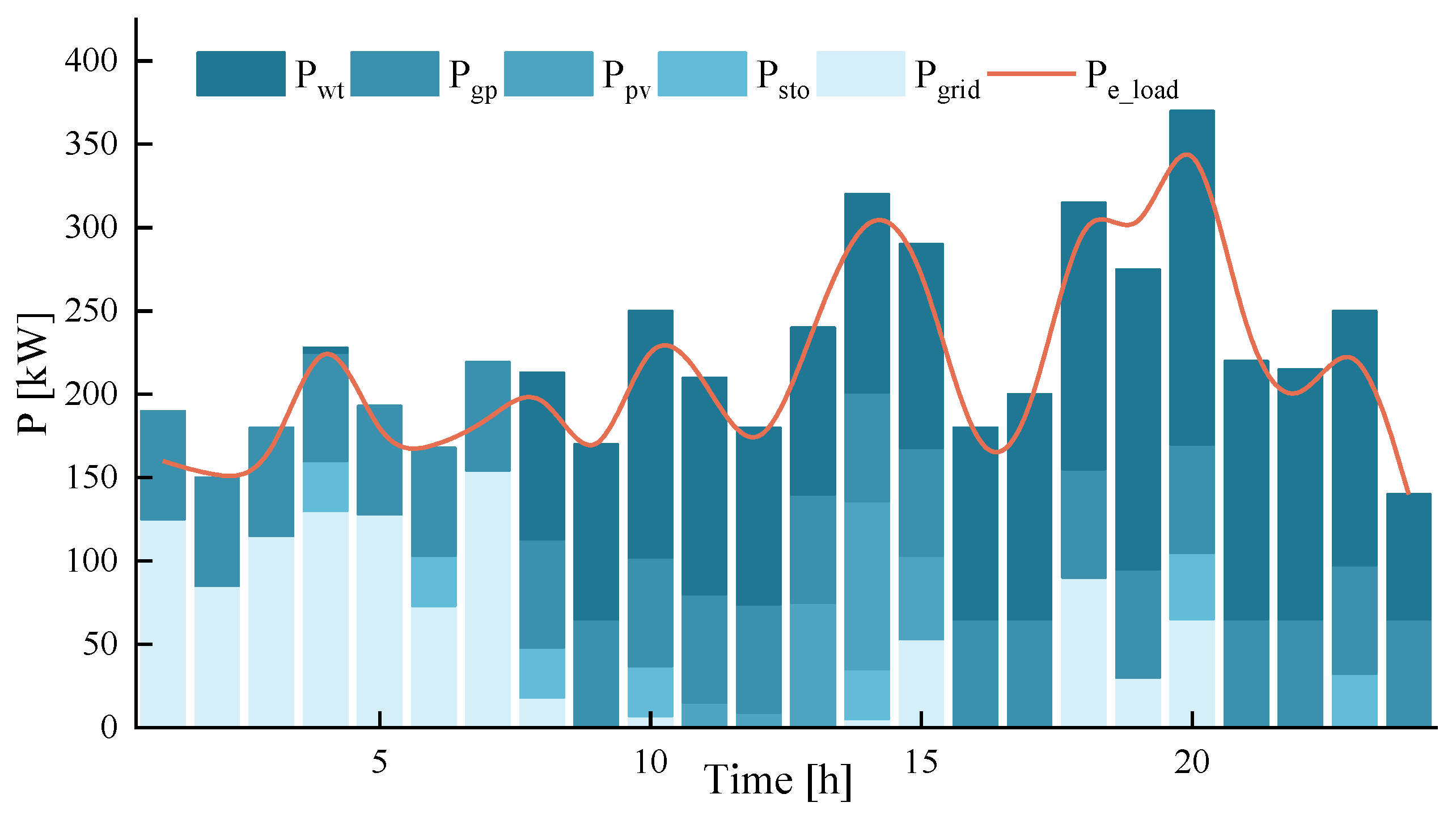
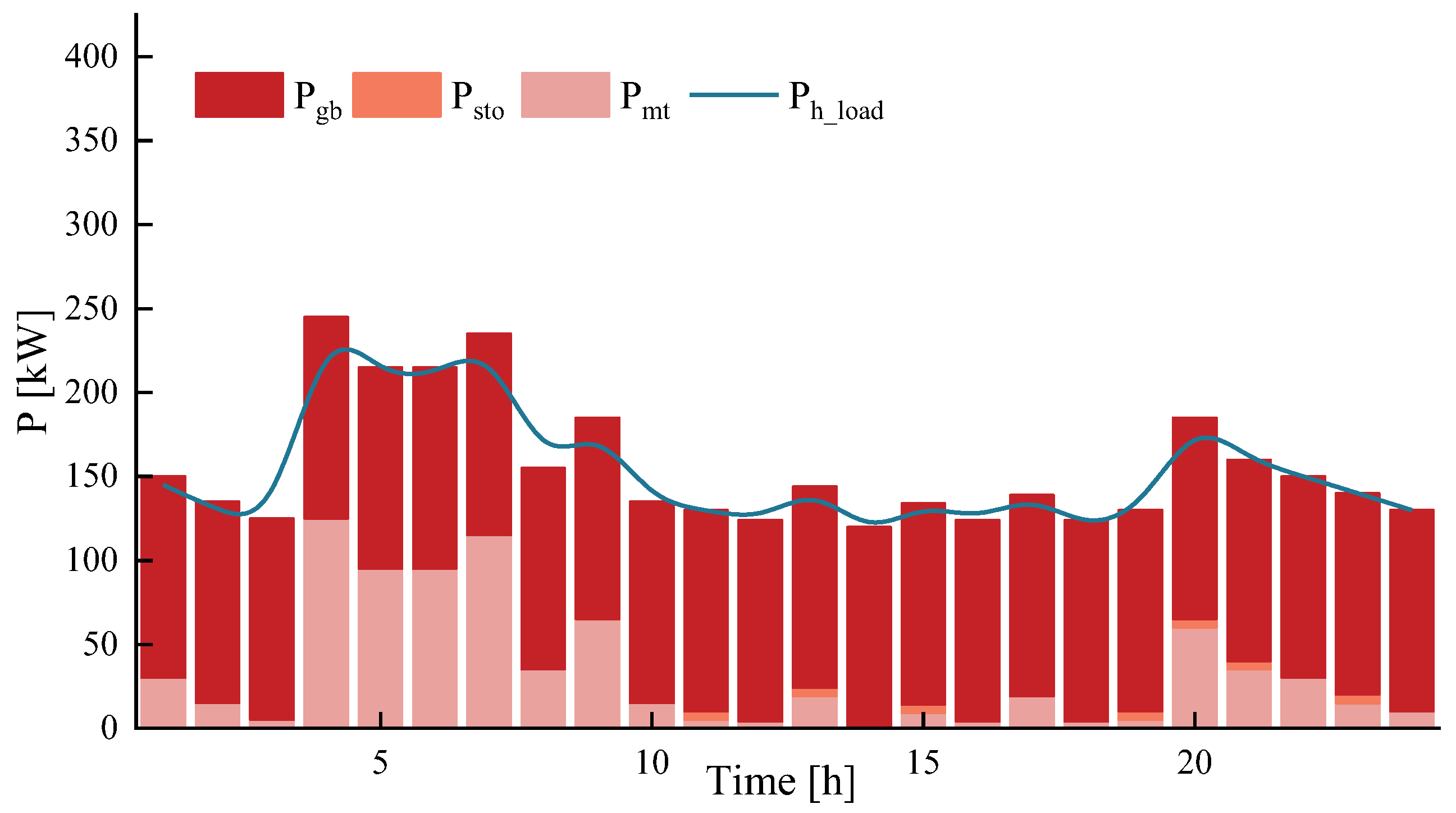
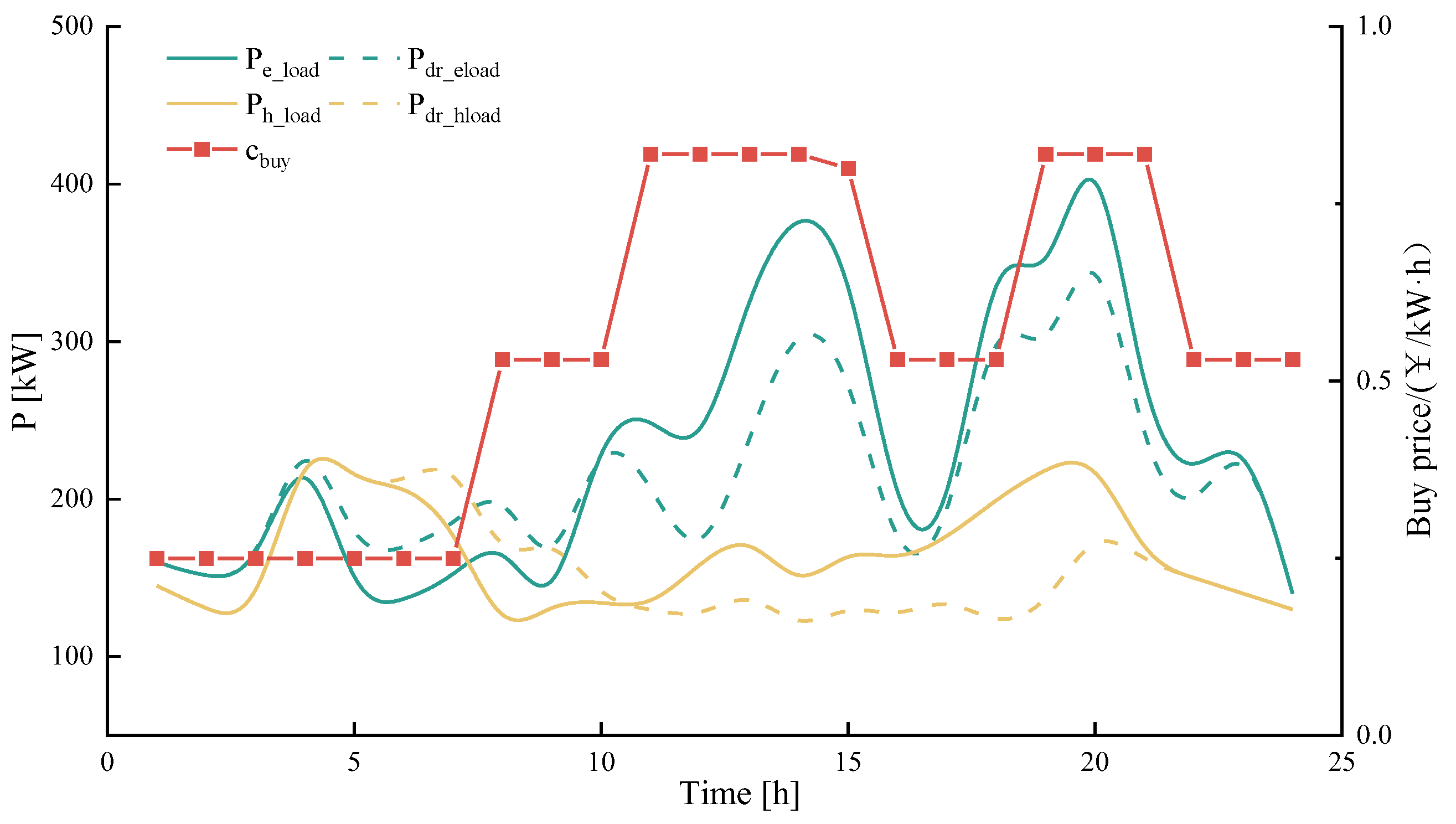
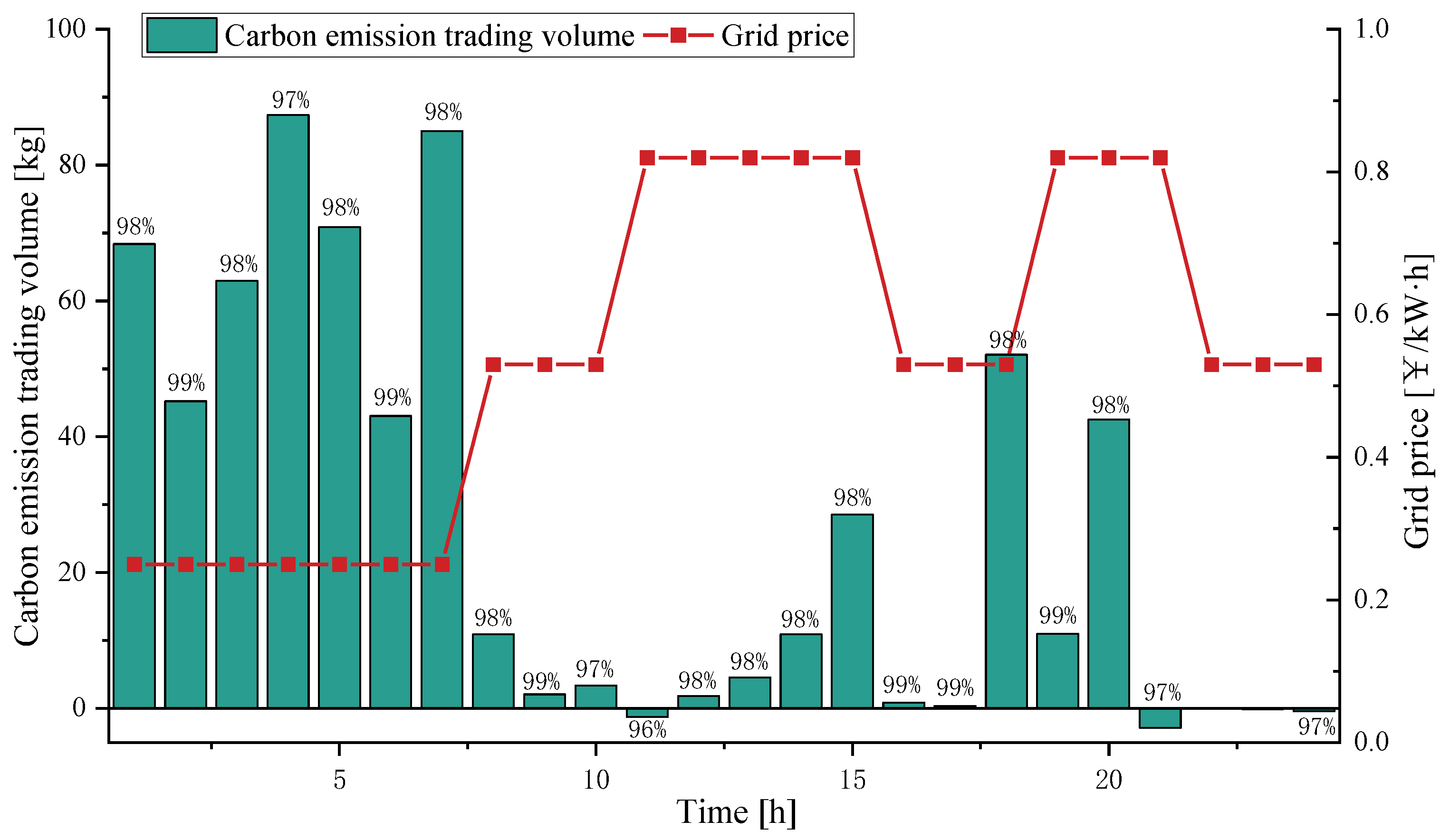
| Time Period | Buy Price [¥/kW·h] | Sell Price [¥/kW·h] |
|---|---|---|
| 00:00–7:00 | 0.25 | 0.25 |
| 7:00–10:00 | 0.53 | 0.42 |
| 15:00–18:00 | ||
| 21:00–00:00 | ||
| 10:00–15:00 | 0.82 | 0.65 |
| 18:00–21:00 |
| Generator | Lower Limit [kW] | Upper Limit [kW] | Running Cost [¥/kW·h] |
|---|---|---|---|
| PV | 0 | Predicted value | 0.52 |
| WT | 0 | Predicted value | 0.72 |
| Gas boiler | 0 | 100 | Natural gas price |
| Gas turbine | 0 | 200 | Natural gas price |
| Storage | 45 | 95 | 0.5 |
| Power | Carbon Emission Coefficient [g/(kW·h)] | Quota Coefficient [g/(kW·h)] |
|---|---|---|
| PV | 43.0 | 78.0 |
| WT | 154.5 | 78.0 |
| Coal power | 1303.0 | 798.0 |
| Natural gas | 564.7 | 424.0 |
| Storage | 91.3 | 0 |
| Scenarios | Flexible Load Participation | Contrast Point |
|---|---|---|
| Scenario 1 | Flexible electrical and heat load | Operating cost and load interaction |
| Scenario 2 | Only flexible electrical load | |
| Scenario 3 | Without flexible load |
| Scenarios | Scenario 1 | Scenario 2 | Scenario 3 |
|---|---|---|---|
| Cgrid_buy | 422.4155 | 458.5074 | 725.7155 |
| Cgrid_sell | −5.08 × 10−13 | −1.69 × 10−13 | −1.3401 × 10−13 |
| Cfu_gas | 1103.8668 | 1084.0341 | 1177.2766 |
| Cpw_om | 1352.9341 | 1365 | 1419.2324 |
| Csto_om | 289.4192 | 283.7727 | 289.559 |
| Cdr | −251.7222 | −177.4 | 0 |
| Cco2 | 143.3098 | 149.6765 | 196.353 |
| Z [¥] | 3060.2232 | 3163.5907 | 3808.1365 |
Disclaimer/Publisher’s Note: The statements, opinions and data contained in all publications are solely those of the individual author(s) and contributor(s) and not of MDPI and/or the editor(s). MDPI and/or the editor(s) disclaim responsibility for any injury to people or property resulting from any ideas, methods, instructions or products referred to in the content. |
© 2024 by the authors. Licensee MDPI, Basel, Switzerland. This article is an open access article distributed under the terms and conditions of the Creative Commons Attribution (CC BY) license (https://creativecommons.org/licenses/by/4.0/).
Share and Cite
Li, B.; Zhou, Z.; Hu, J.; Yi, C. Research on Optimal Scheduling Strategy of Differentiated Resource Microgrid with Carbon Trading Mechanism Considering Uncertainty of Wind Power and Photovoltaic. Energies 2024, 17, 4633. https://doi.org/10.3390/en17184633
Li B, Zhou Z, Hu J, Yi C. Research on Optimal Scheduling Strategy of Differentiated Resource Microgrid with Carbon Trading Mechanism Considering Uncertainty of Wind Power and Photovoltaic. Energies. 2024; 17(18):4633. https://doi.org/10.3390/en17184633
Chicago/Turabian StyleLi, Bin, Zhaofan Zhou, Junhao Hu, and Chenle Yi. 2024. "Research on Optimal Scheduling Strategy of Differentiated Resource Microgrid with Carbon Trading Mechanism Considering Uncertainty of Wind Power and Photovoltaic" Energies 17, no. 18: 4633. https://doi.org/10.3390/en17184633
APA StyleLi, B., Zhou, Z., Hu, J., & Yi, C. (2024). Research on Optimal Scheduling Strategy of Differentiated Resource Microgrid with Carbon Trading Mechanism Considering Uncertainty of Wind Power and Photovoltaic. Energies, 17(18), 4633. https://doi.org/10.3390/en17184633








